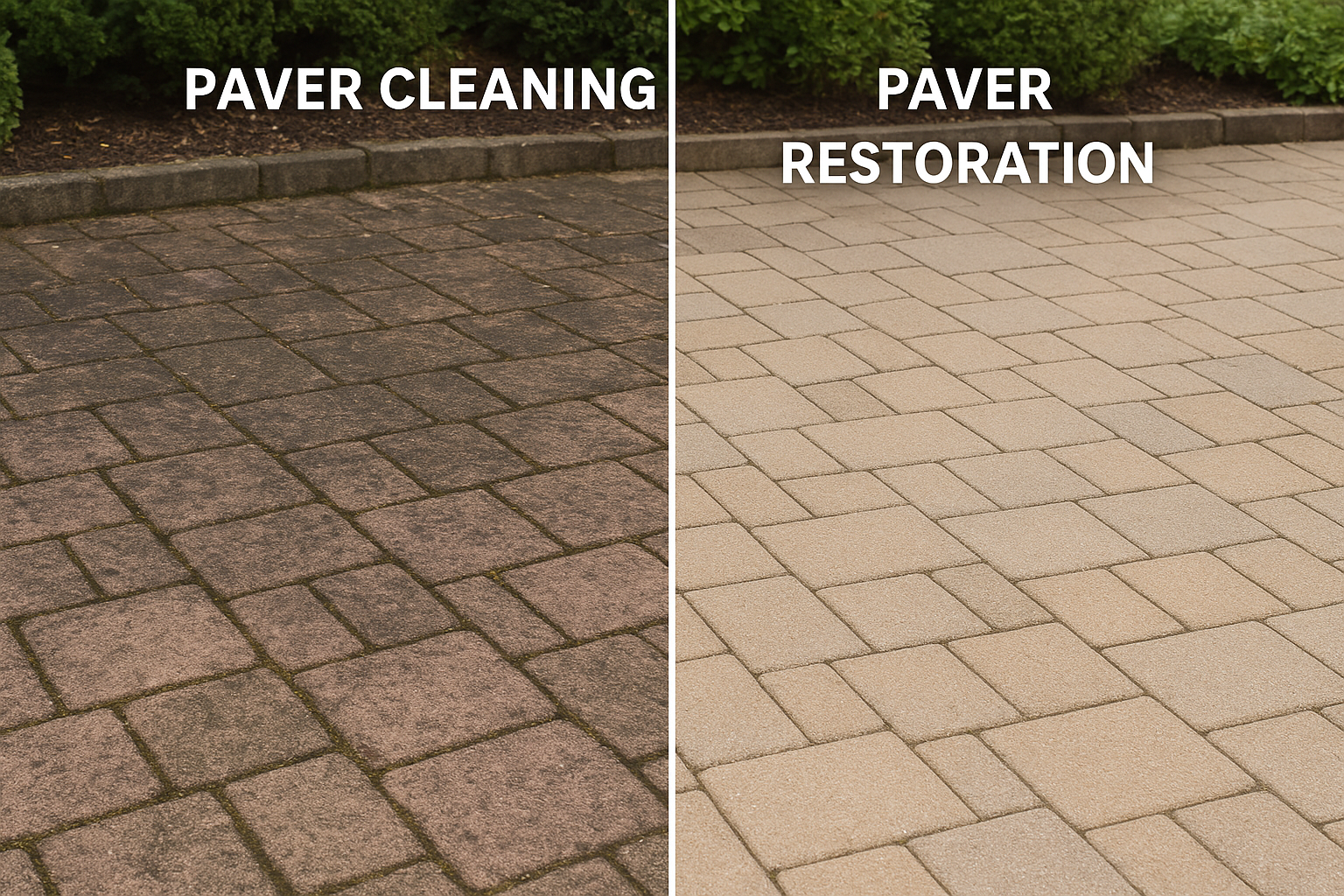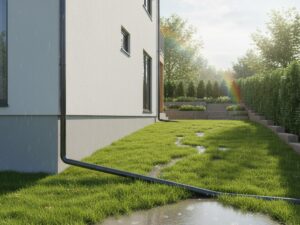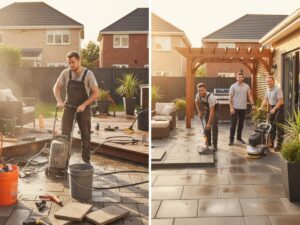At first glance, a dull or stained patio often looks like it just needs a quick wash. But outdoor spaces tell a bigger story than surface dirt alone. Sometimes the issue can be more than moss or grime; it’s sinking edges, loose joints, or cracked pavers quietly stealing the beauty and safety of your walkway or driveway. That’s where the real decision comes in: is it simple, clean enough, or does your space need full restoration to bring it back to life?
This blog will guide you through paver cleaning vs. paver restoration, explain the benefits of each, and share tips to keep your pavers looking great for years.
What is Paver Cleaning
Paver cleaning preserves the structure and safety of hardscaped areas by targeting hidden issues beyond surface grime. This preventative care supports proper drainage, limits moss regrowth, and reduces slip hazards, helping patios, driveways, and walkways remain solid and durable for everyday use and heavy foot traffic.
What is Included in Paver Cleaning
Here are various steps included in paver cleaning:
Preparation
Before cleaning starts, the area is cleared of furniture, planters, or any objects that might block access to the pavers. This step guarantees a thorough process and prevents damage to surrounding items.
Weed and Moss Removal
Weeds, moss, and lichen often grow in the joints and on the surface of pavers. These are manually removed using hand tools and a stiff-bristled brush to loosen unwanted growth. Removing this organic matter prevents joint erosion, reduces slipping hazards, and maintains the overall appearance of the paved area.
Surface Pre-Treatment
Sections with oil stains, mold, or mildew receive specialized treatments. A degreaser removes oil or grease spots, while an algaecide neutralizes mold and mildew at a molecular level. A professional paver patio contractor ensures that the pavers are clean and ready for the next step.
Deep Cleaning
Technicians wash the pavers thoroughly using a pressure washer, often with a flat surface cleaner attachment. This removes dirt, grime, and loose organic matter from both the surface and the joints, restoring the natural color and vibrancy of the pavers.
Stain Removal
For stubborn stains that cannot be removed by standard washing, a paver-safe, non-acidic cleaner or an oxygen bleach mixture is applied. This effectively lifts deep-set dirt, rust, or organic stains without harming the pavers or the surrounding landscape.
Rinsing
After cleaning and stain treatment, the entire area is thoroughly rinsed with clean water to remove all loosened debris, residues, and cleaning agents. This ensures that the pavers are left clean and ready for the next step.
Joint Refill
The final step involves replenishing the sand in the paver joints, typically using kiln-dried silica sand. This step provides structural support, locks the pavers in place, prevents shifting, and reduces the chances of weed growth. Proper joint refilling is essential for both the durability and aesthetic appeal of the paved surface.
When Do You Need a Cleaning Service for Pavers
Paver cleaning is required if your pavers:
- Have accumulated dirt, stains, or discoloration over time but are structurally sound.
- Show minor moss, algae, or weed growth that can be removed without major repairs.
- Are part of a routine maintenance schedule to keep outdoor spaces looking fresh and attractive.
Regular cleaning can also prevent small issues from escalating into more serious problems that would require patio restoration.
What Is Paver Restoration
Paver restoration is a comprehensive process that repairs and revitalizes worn or damaged outdoor surfaces to extend their lifespan. There are many benefits of paver restoration service, such as restoring structural integrity and ensuring patios, driveways, and walkways remain safe and long-lasting.
What is included in paver restoration
A paver restoration service includes the following steps:
Cleaning
Restoration begins with thorough cleaning, similar to paver cleaning but more intensive. Dirt, moss, algae, and surface stains are carefully removed using pressure washing and specialized cleaning solutions. This step not only revives the natural color of the pavers but also prepares the surface for repairs and sealing, ensuring that treatments adhere properly and provide long-lasting protection.
Repairs and Replacement
Cracked, chipped, or sunken pavers are repaired or replaced during restoration, and these measures provide multiple benefits, including reduced maintenance and protection against shifting or cracking. In many cases, the base beneath the pavers is inspected and re-leveled to correct drainage problems or areas where the foundation has settled. This structural adjustment is necessary for creating a stable surface that resists future shifting, prevents water pooling, and eliminates trip hazards. Addressing the underlying foundation also tackles common broken patio paver causes, such as soil erosion, poor installation, or heavy load pressure, ensuring the paved area can safely withstand heavy foot traffic and vehicle loads.
Joint Sand Replenishment
Over time, joint sand can erode or wash away, which can cause pavers to shift or become unstable. During restoration, old or lost sand is replaced, typically with kiln-dried silica sand, to lock pavers in place, stabilize the surface, and prevent weed growth. Proper joint sand also improves drainage and helps maintain the paved structural integrity of the paved area.
Sealing
Applying a high-quality sealant is a critical part of restoration. There are numerous benefits of sealing pavers, such as creating a protective barrier that guards against stains, fading, water damage, and environmental wear. In addition to protection, sealing enhances the natural color of the pavers, giving them a vibrant, refreshed appearance that lasts for years.
When Do You Need Restoration Service for Pavers
Paver restoration is recommended when:
- Pavers are faded or discolored due to prolonged sun exposure or harsh weather conditions.
- There are visible cracks, chips, or uneven surfaces caused by heavy use or settling.
- Weed growth or shifting has become significant and cannot be remedied through cleaning alone.
- You want to restore the original beauty of the pavers and improve their durability for years to come.
Restoration is a more intensive and long-term solution compared to cleaning. It is often required every 3–5 years, depending on the climate and maintenance practices.
Conclusion
Don’t let worn or damaged pavers ruin the look or safety of your outdoor spaces. At My Landscape Contractor, our expert team provides professional paver restoration and cleaning services that bring your driveways, patios, and walkways back to life.




